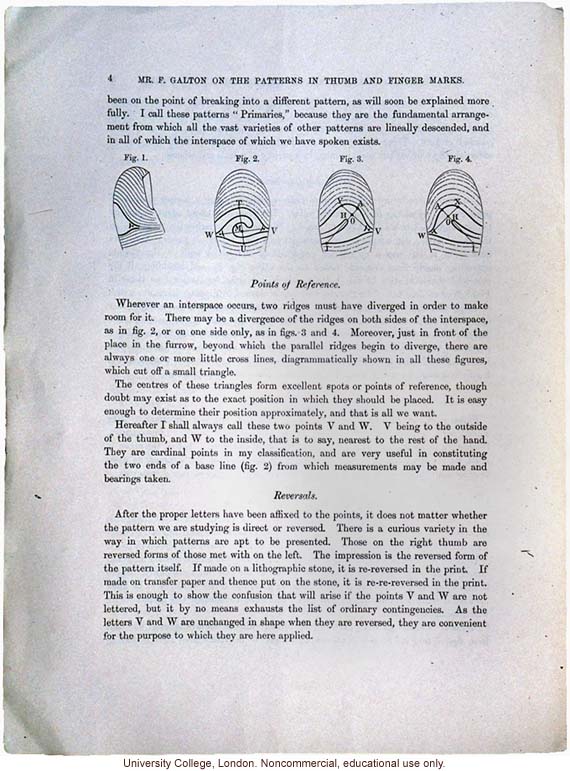4 Mr. F. Galton on the Patterns in Thumb and Finger Marks
been on the point of breaking into a different t pattern, as will soon be explained more fully. I call these patterns "Primaries," because they are the fundamental arrangement from which all the vast varieties of other patterns are lineally descended, and in all of which the interspace of which we have spoken exists.
[figures 1-4]
Points of Reference.
Wherever an interspace occurs, two ridges must have diverged in order to make room for it. There may be a divergence of the ridges on both sides of the interspace, as in fig. 2, or on one side only, as in figs. 3 and 4. Moreover, just in front of the place in the furrow, beyond which the parallel ridges begin to diverge, there are always one or more little cross lines, diagrammatically shown in all these figures, which cut off a small triangle.
The centers of these triangles form excellent spots or points of reference, though doubt may exist as to the exact position in which they should be placed. It is easy enough to determine their position approximately, and that is all we want.
Hereafter I shall always call these two points V and W. V being to the outside of the thumb, and W to the inside, that is to say, nearest to the rest of the hand. They are cardinal points in my classification, and are very useful in constituting the two ends of a base line (fig. 2) from which measurements may be made and bearings taken.
Reversals.
After the proper letters have been affixed to the points, it does not matter whether the pattern we are studying is direct or reversed. There is a curious variety in the way in which patterns are apt to be presented. Those on the right thumb are reversed forms of those met with on the left. The impression is the reversed form of the pattern itself. If made on a lithographic stone, it is re-reversed in the print. If made on transfer paper and thence put on the stone, it is re-re-reversed in the print. This is enough to show the confusion that will arise if the points V and W are not lettered, but it by no means exhausts the list of ordinary contingencies. As the letters V and W are unchanged in shape when they are reversed, they are convenient for the purpose to which they are here applied.
[end]


